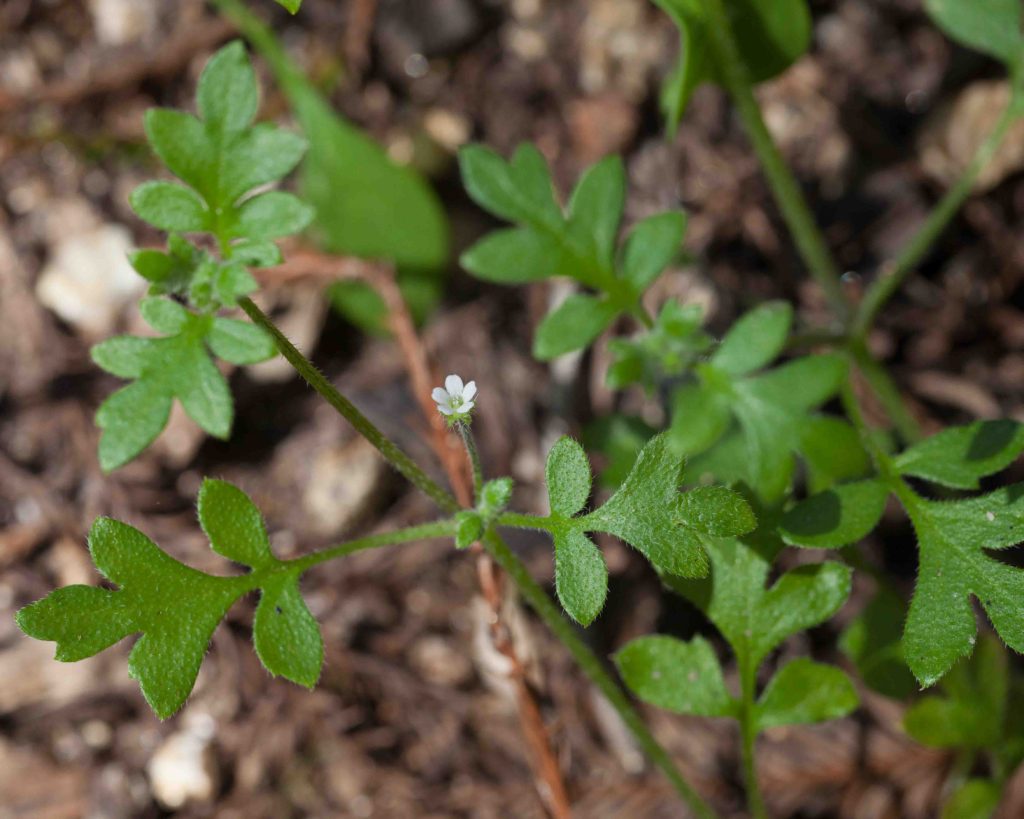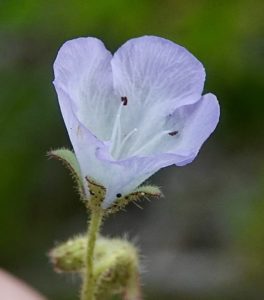Hydrophyllaceae: Waterleaf Family — Baby Blue-eyes & Fiesta Flower
Most members of the Waterleaf family have their flowers arranged in coiled (scorpioid) cymes. The 5 petals are partly united, to form a bell or funnel shape. The 5 stamens are often longer than the petals, with a 2-lobed stigma. Closely related to the Borage family.
Common Eucrypta – Eucrypta chrysanthemifolia var. chrysanthemifolia
Blooms:
Mar–June
Plant Height:
20–50 cm
Flower Size:
Small
Origin:
Native
Habitat:
Roadsides, after fires and rocky places near coast
Notes:
This is an erect plant with a loose, sprawling growth habit. It has many small flowers, 4–8 mm across, generally 8–15 per branch. Flowers are bell-shaped, whitish with blue-purple veins. Leaves are glandular and ciliate, 2–3-pinnately lobed. Lower leaves are larger than upper. Unlike Nemophila and Pholistoma (see below), there are no appendages between the calyx lobes.
Baby Blue-eyes – Nemophila menziesii var. menziesii
Blooms:
Feb–June
Plant Height:
10–30 cm
Flower Size:
Medium
Origin:
Native
Habitat:
Grassland, woodland, chaparral
Notes:
A strikingly pretty flower, quite common in early spring and unmistakable. Flowers are pale to mid-blue, with a white center. The petals may have black dots and dark blue veins. Pure white forms are occasionally found. There is a separate variety (var. atomaria) which is pure white, with black dots from the center to the petal margin. The photo on the right may be this variety, or simply a white form of var. menziesii.
Small-flowered Nemophila – Nemophila parviflora var. parviflora
Blooms:
Mar–July
Plant Height:
Stems 10–60 cm
Flower Size:
Very small
Origin:
Native
Habitat:
Woodland
Notes:
The tiny flowers are no more than 5 mm across, pure white or pale blue but without any dark spots or streaks. Styles and stamens are included. Leaves are asymmetric and noticeably hairy, 1–4 cm long and generally 5-lobed.
Meadow Nemophila – Nemophila pedunculata
Blooms:
Feb–July
Plant Height:
Stems 10–30 cm
Flower Size:
Small
Origin:
Native
Habitat:
Many
Notes:
This plant has bristly stems, and 10-35 mm leaves with 5-9 fleshy lobes. Stems are often prostrate. Small flowers (2-8 mm across), white or blue. Most are white, with small blue streaks or purple spots on the petals. On Ft. Ord, they are white, without spots but may show a purplish tinge. The photos shown here are the Ft. Ord type. Photos by CJH.
Fiesta Flower – Pholistoma auritum var. auritum
Blooms:
Mar–June
Plant Height:
20–120 cm
Flower Size:
Medium
Origin:
Native
Habitat:
Ocean bluffs, woodland, streambanks
Notes:
Very common in early spring in woodland. It has a vine-like, sprawling growth habit with a profusion of bluish-purple (occasionally lighter-colored) flowers. Related to Baby Blue-eyes (Nemophila menziesii, see above), it has the same reflexed appendages between the sepals. These and the stems have small hooks, which readily attach to clothing – hence its use as an inexpensive corsage. Photos #1, 3 and 4 by CJH.
White Fiesta Flower – Pholistoma membranaceum
Blooms:
Feb–May
Plant Height:
10–60 cm
Flower Size:
Small
Origin:
Native
Habitat:
Bluffs, wooded slopes
Notes:
Much less common than the purple-colored Fiesta Flower (Pholistoma auritum, see above), but with a similar vine-like, sprawling growth habit. Its flowers are smaller (< 1 cm across) and pure white, with a purple spot on each lobe. Often found in profusion, especially under oak trees. Photos #3-4 by CJH.






















